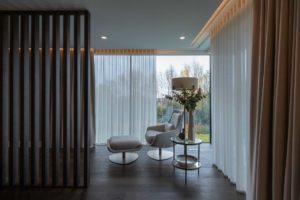Bringing the cinema experience home is more accessible than it has ever been.
Before you start your project, you need to consider how you will use the space, the room layout and the technology.
Before starting out on your home cinema journey you need to carefully consider several aspects, from the room dimensions and layout, how you might use the space and which equipment offers the best performance for your budget.
Room
If you’re considering a home cinema then you’ve probably already given some thought as to where you want to locate it. Playrooms outgrown by children are a popular space, as are spare bedrooms, garden rooms and attic spaces. Home cinemas don’t have to be dedicated rooms as equipment can be cleverly hidden away while not in use. You could have a wall mounted television in your sitting room for day-to-day viewing, but at the touch of a button, a projector and screen can lower from the ceiling, while blackout blinds plunge the space into darkness, ready to watch a blockbuster movie, concert or sporting event.
Layout
The layout of the room will be governed by several factors, including the type of seating, room dimensions and how you intend to use the space. Give some thought as to how many people might use the space at any one time and consider how you might accommodate friends and family too. Independent cinema chairs are popular for dedicated rooms, but in smaller spaces they can be restrictive due to their size. Would a flexible sofa solution be more appropriate for your needs, allowing you to squeeze more people in or cosy up with your loved ones?
Visual display
Once you have decided upon the type of seats and their positions you can look at the visual display options. Large television screens can be a good option in small spaces as they offer high brightness levels, are quick to power up and they can be inexpensive. However, for a true cinema experience you need scale too, which is where a projector and screen combination come into play. With projectors now offering laser or LED lamp technology they power up far quicker and are quieter than their predecessors and offer good value too. For the largest applications, where performance is more important than budget, there are LED panel solutions such as Samsung’s ‘The Wall’ which offer TV like viewing on a huge scale.
Comfortable viewing
A consideration when selecting your visual display is how comfortable it’ll be to watch content. If the image is too small then the experience will be hugely disappointing, too large and it’ll be fatiguing over long periods. Look at each row of seats and calculate the viewing angle from the extremities of the image to the seat, both horizontally and vertically. Look to achieve 30° or more horizontally and 15° or more vertically. A good guide as to how you should size your screen is where you sit at a commercial cinema. Are you a front, middle or back row person? For rooms with more than one row of seats we suggest a 450mm platform height for each row, which should give unobstructed viewing.
Loudspeakers & amplification
When selecting your loudspeakers and amplification you again need to consider your room use. If you are building a dedicated cinema room then you should be looking to install audio equipment that can deliver reference level audio at the seating position. This reference level ensures that the performance is delivered with the correct impact, with enough headroom to deliver those room shaking explosions and high impact energy when required. For this, you need to consider amplification power and loudspeaker efficiency to ensure that you can hit 105dB at the seating position. As for loudspeaker brands, again consider your room use, if you’ll listen to music or watch concerts on your system then ensure you pick out a solution that is musically capable but specified highly enough for action movies too. For budget systems there are plenty of brands that deliver high volume levels without breaking the bank.
Surround sound formats
There are many different surround sound formats for your consideration. As an absolute minimum we’d suggest a 7.1 layout, which means seven surround sound speaker positions and one subwoofer. With 3D audio now commonplace, we’d suggest installing loudspeakers in the ceiling too, to benefit from the height effects. A 7.2.4 format is popular with many of our clients as this offers seven surround sound loudspeaker positions, two independent subwoofers and four height channels. For larger spaces, the number of loudspeaker channels should be increased for more even coverage and a more immersive experience.
Acoustic construction
To get the best surround sound experience, seating shouldn’t be tight up against the rear or side walls of a cinema room. You should also avoid placing seats 25% of the room width in from the side walls, and 25% of the room length from the rear wall. These locations can suffer with acoustic nulls and offer lack-lustre performance. If your cinema room needs to be isolated, to avoid sound travelling to other areas of the house, then that must be considered from the very earliest stage. That build process is complex, and thought must be given to every construction detail. The cinema would need to be built as a room within a room, with suitable doors and an entrance vestibule.
Acoustic treatment
Another important consideration is acoustic treatment within the space, to ensure the best listening experience. In an untreated room, sound waves from the loudspeakers will reflect off hard surfaces, echoing around the space. This can result in less accuracy in the space. The end goal is to achieve a system where your brain can pinpoint exactly where the action is occurring, a cleverly designed combination of absorbing and scattering panels is key, along with a thick carpet and plenty of soft furnishings.
Control
As you might imagine, a cinema system can consist of several pieces of equipment, which could be complicated to set up and use. We recommend simplifying the control by way of an intuitive handheld remote control, to take away all the stress. When you press a ‘Movie’ button on the remote, the projector turns on, your movie server content is displayed on-screen ready for selection, the audio system kicks into life and the lights dim down. Touchscreens and iPads could be considered, but nothing beats a remote control in a cinema room as they are simpler to use and far more tactile.
If you need help to create a high performance cinema at home, get in touch with our expert design team today enquiries@cleverass.com




